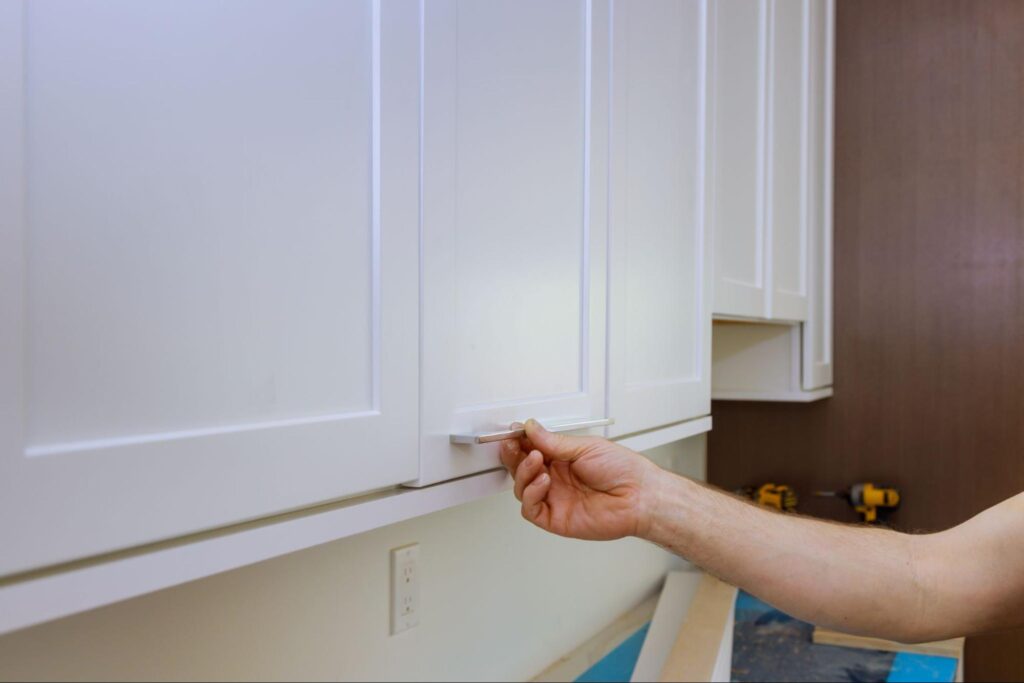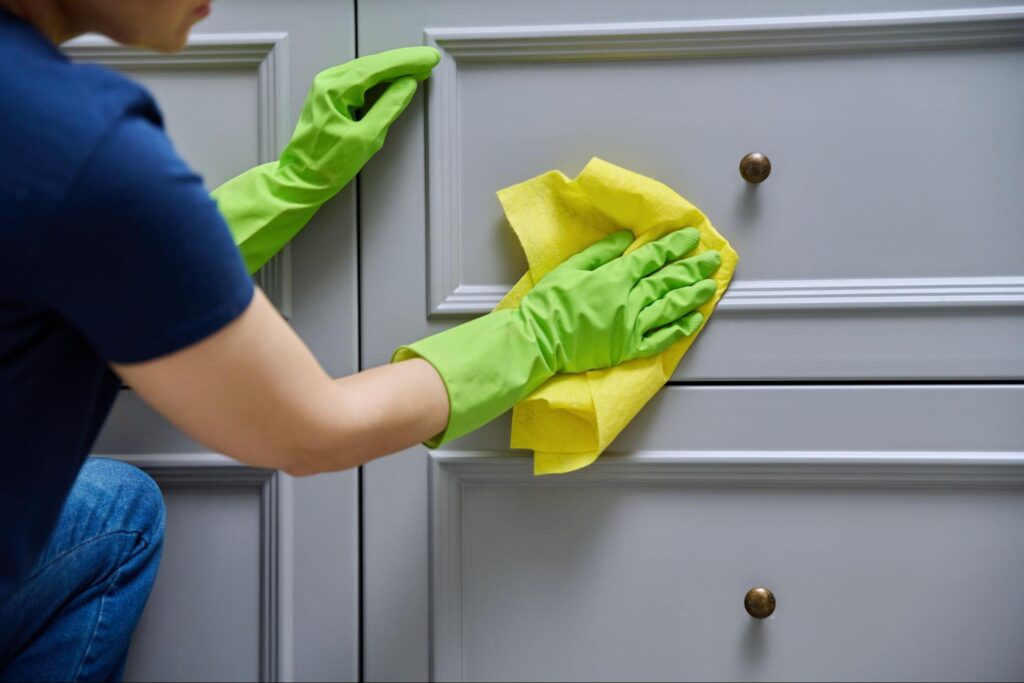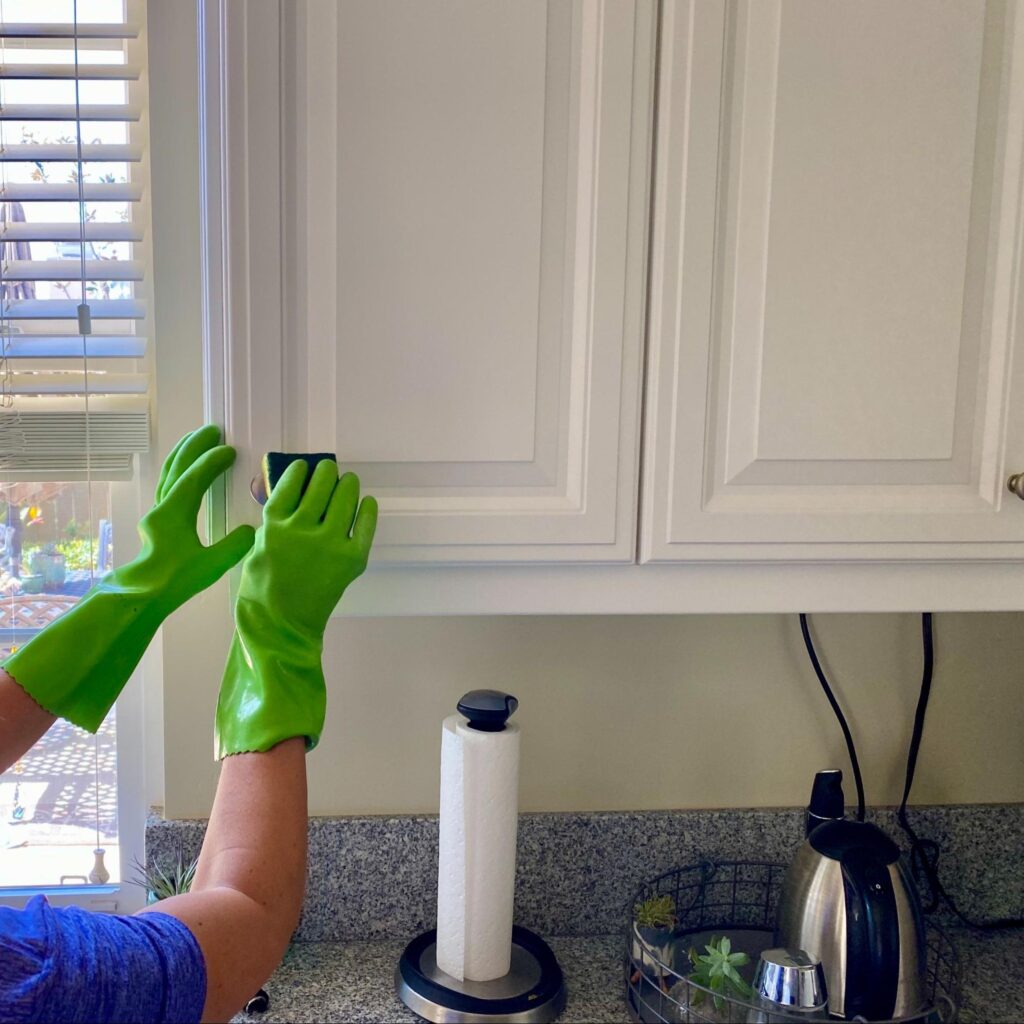
Repainting cabinets can instantly refresh your space without a complete remodel. Whether it’s the kitchen, bathroom, or laundry room, those painted surfaces bring new life to old fixtures. But the real effort begins once the work is done, protecting that finish. Every fingerprint, scratch, or steam cloud has the potential to ruin the smooth coat you invested time and money into. How you treat your cabinets from day one shapes how long that fresh look will last.
Why Caring for Painted Cabinets Matters
Painted cabinets face constant use and exposure. They endure splashes, heat, fingerprints, and grime daily in kitchens and bathrooms. A flawless paint job can fade quickly without the proper care. Neglect leads to chipped corners, dull finishes, and sticky surfaces, often within weeks. These issues cost time and money to fix. However, with a few consistent habits, you can extend the life of your cabinets, preserve their color and sheen, and avoid unnecessary repairs.
The Curing Period for Painted Cabinets
Newly painted cabinets may feel dry within hours, but they aren’t ready. Paint takes time to harden, settle, and form a protective surface, known as the curing period. Rushing the cabinet use during this stage increases the risk of damage.
Dry Time Isn’t the Same as Cure Time
Most paints dry to the touch within a day. However, the curing process may take up to 30 days, depending on the type of paint and environmental conditions. Latex paints cure faster than oil-based paints, but temperature and humidity can slow down the curing process. Using cabinets before they’re cured puts the surface at risk for dents and scuffs.
Using Cabinets Gently During the Cure Window
You can use your cabinets during the curing process, but handle them with care. Open and close doors slowly. Avoid slamming drawers or letting hardware clang. Avoid placing anything heavy or moist against cabinet surfaces. Keep kitchen towels, oils, or small appliances away from cabinet edges to limit contact.
Environmental Factors That Affect Cure Time
Cure time isn’t just about the paint; it’s about the environment of your room. Low humidity and mild temperatures help paint harden faster. High humidity or cold can slow the process and leave surfaces tacky for longer. Improve airflow with fans or air conditioners if needed. Always allow space between cabinets, countertops, or appliances to prevent them from pressing against each other.
Cleaning Painted Cabinets the Right Way
Even after curing, painted cabinets still need special handling when it comes to cleaning. Harsh cleaners or abrasive tools will wear away the finish faster than regular use. Maintaining a clean surface doesn’t mean scrubbing hard; it means choosing the right approach.
Use Only Gentle, Non-Abrasive Cleaners
Stick to mild, pH-balanced cleaners designed explicitly for painted wood or other surfaces. Avoid using bleach, ammonia, and vinegar, as they can dull the finish or strip color. A drop of dish soap mixed with warm water often works best. Spray lightly on a cloth, not directly on the cabinet. Always test a small hidden spot before cleaning a large area.
How to Clean Cabinets Without Causing Damage
Use a soft microfiber cloth for regular cleaning. Wipe in the direction of the wood grain or brush strokes if visible. Rinse the cloth often to avoid spreading grease or debris. Dry the surface after cleaning to prevent moisture damage. Focus more on consistency than deep cleaning; gentle, regular upkeep is more effective over time.
Dealing With Grease Around Cooking Areas
Grease near stoves can be stubborn. Use a damp sponge dipped in mild dish soap and water. Let the soap sit briefly on the grime, then gently wipe it off. Don’t scrape or scrub aggressively. If needed, use a degreaser labeled safe for painted finishes. Always dry the cabinet with a clean cloth afterward.
How to Prevent Damage to Painted Cabinets
Beyond cleaning, protecting your cabinets from daily wear and tear is just as important. Scratches, steam damage, and loose hardware can shorten their lifespan. A few smart changes make a lasting impact:

Manage Moisture Before it Ruins the Finish
Steam from dishwashers or boiling pots can cause the paint on cabinets to peel or blister. Wipe surfaces dry after cooking or cleaning. Use vent hoods and fans to redirect steam. Keep cabinets near sinks or stoves dry at all times. If condensation forms regularly, increase ventilation in the room to prevent further issues.
Adjust or Replace Cabinet Hardware As Needed
Loose knobs and misaligned hinges stress the paint. Tighten hardware regularly to avoid wobbling or scratches. Use rubber bumpers to soften the impact of closing doors. Consider installing soft-close systems if slamming is a common issue. Upgraded pulls also reduce direct contact with painted surfaces.
Long-Term Painted Cabinet Maintenance
Maintaining cabinets doesn’t stop after curing and cleaning. Over time, painted surfaces naturally wear. With some planning, minor repairs and touch-ups prevent bigger problems from forming.
Perform Small Touch-Ups When Needed
Touch-up paint should match the original type and sheen. Use a fine-tip brush or a foam applicator for clean, precise lines. Don’t overload the brush; thin coats look better and last longer. Lightly sand damaged areas before applying paint to smooth edges. Let it dry completely before touching or using the cabinet.
Schedule Yearly Maintenance Checks
Inspect all cabinet doors and drawers at least once a year for signs of peeling, bubbling, or discoloration. Pay close attention to corners and high-touch areas. If minor damage is noticed, repair it immediately. A full repaint isn’t always needed, as spot repairs can stretch the life of the finish.
Use Wax or Polish Sparingly, if at All
Some cabinet paints allow for light waxing, but not all do. Only use wax approved for painted finishes and avoid frequent application. Too much wax can build up and cause the material to yellow. Always apply with a soft cloth and buff gently. Skip polishes with silicone or oil that may cloud or stain over time.
Protecting Painted Cabinets from Daily Wear
Even if you clean and maintain your cabinets regularly, how you use them daily affects their longevity. Small habits, repeated daily, either protect or wear down your paint.
Avoid Overstuffing Cabinets and Drawers
Overloaded shelves cause sagging and door warping; heavy contents also increase the risk of sudden slams. Use lightweight storage bins to distribute weight evenly. Rotate items you use often to prevent repeated wear on specific areas. Don’t use cabinet interiors as extra support for large appliances or cookware.
Add Shelf Liners and Pads for Extra Protection
Non-adhesive liners protect painted shelves from moisture and scratches. They also prevent items from sliding and scraping surfaces. Choose liners that are easy to clean and cut to fit. Replace them when worn or stained. You can also add felt pads behind doors to reduce impact.
Limit Direct Sunlight and Heat Exposure
Paint fades or cracks when exposed to intense sunlight. Use blinds or curtains in rooms that receive a lot of sunlight. Avoid placing toasters or coffee machines directly under cabinets. Heat from those appliances can damage paint over time. Reorganize countertop layouts to shield cabinets from unnecessary warmth.

Knowing the Ingredients That Damage Painted Cabinets
Not all cleaners labeled as “gentle” are safe for use on painted surfaces. Some contain hidden acids, oils, or solvents that wear away cabinet finishes over time. Even popular natural options, such as citrus oil, baking soda paste, or vinegar, can damage paint if used frequently. It’s essential to check the ingredient list before spraying anything on your cabinets.
Ingredients to Avoid in Everyday Cleaners
Many household cleaners contain chemicals that seem harmless but aren’t. Ammonia, bleach, and sodium hydroxide break down paint over time. Even alcohol-based wipes can dull the surface if used repeatedly. These ingredients clean well, but shorten your cabinet’s lifespan. Avoid anything labeled as a “heavy-duty” or “deep-cleaning” agent.
The Risks of Natural and DIY Products
DIY and natural cleaners may seem like safer options, but they often contain acids. Citrus oils, vinegar, and baking soda affect paint when used frequently. They break down the protective finish and weaken the bond between layers, leading to fading, chipping, or sticky surfaces over time. Always research DIY mixes before using them on painted cabinets.
Choosing Safe Alternatives for Painted Surfaces
Look for pH-neutral cleaners specifically designed for wood or painted surfaces. A small amount of dish soap diluted in warm water is usually safe. Spray the cleaner on a cloth, never directly on the cabinet. Use a microfiber cloth to avoid friction. Always test a small, hidden section before cleaning the whole area.
How Seasonal Changes Affect Painted Cabinet Care
Painted cabinets react to changes in humidity, temperature, and light. In the summer, higher humidity can soften paint and cause doors to swell, resulting in sticky drawers or paint that rubs off on contact. Winter, on the other hand, can cause shrinkage and cracking in older wood cabinets.
Summer Humidity and Paint Softening
Warm months bring moisture that seeps into wood and paint layers. That causes cabinet doors to swell, resulting in tight closures or paint-on-paint contact. Sticky finishes become more common in these conditions. Use fans or dehumidifiers to maintain a comfortable humidity level. Allow extra space between items and painted surfaces to reduce friction.
Cold Weather Shrinkage and Cracking
Low humidity during winter dries out wood and makes paint brittle. You might see hairline cracks or feel the surface becoming rough. Cabinets near windows or exterior walls are especially vulnerable. Run a humidifier if your indoor air feels overly dry. Check corners and edges for signs of shrinking or splitting.
Preventing Long-Term Seasonal Damage
Use consistent climate control to protect your painted surfaces. Avoid placing cabinets too close to heating vents or direct sunlight. Maintain steady interior temperatures and humidity whenever possible. Open windows briefly each day in spring or fall to balance airflow. Small actions each season help extend the life of your painted cabinets. If you’re unsure how your environment affects them, consult professional painters familiar with climate-based wear.
Avoiding Common Painted Cabinet Mistakes
Most cabinet problems stem from a few bad habits. Learning what not to do can help protect your painted surfaces for years to come. Avoiding these issues takes little effort but makes a significant difference.
Don’t Use Harsh Scrubbers or Scouring Pads
Abrasive tools wear down paint faster than anything else. They may remove stains but leave scratches behind. Stick to soft cloths or non-scratch sponges. If something’s stuck on, soak and wipe, but never scrape. The smoother the surface stays, the longer it resists grime.
Avoid Ignoring Chips or Dents
Even tiny chips can lead to bigger issues, such as peeling. Moisture and air seep under the surface, weakening the bond. Always touch up small areas before they spread. Keep a small container of matching paint handy. A quick fix now prevents more extensive repairs later.
Don’t Overclean or Recoat Too Often
Scrubbing too hard or painting too often can backfire. Frequent cleaning with strong products weakens the top layer. Too many recoats can cause uneven surfaces or cracking. Clean only as needed and stick to proper materials. Repaint only when necessary and always prep first.
Keep Your Painted Cabinets Worth the Work
Fresh paint brings new energy to a space, but it fades quickly without proper care. Routine habits, not major repairs, decide how long that finish lasts. Small steps, such as wiping gently, avoiding harsh products, and watching the seasons, make all the difference. The value isn’t just in how cabinets look today, but how they hold up through daily use. Protect that investment with action, not just intention.
Want more expert tips like these? Visit the Euro Painting blog for practical advice on keeping your space looking its best.

